Meet Chris and Jennifer.
They’ve been working hard to lose fat for several months now and have made progress but the good times seem to be coming to an end.
Chris still has a “pooch” covering his abs and his pudgy love handles are driving him nuts. Jennifer can’t understand why her upper body has thinned out nicely but her hips, thighs, and butt fat are holding on for dear life.
Well, Chris and Jennifer aren’t alone. If you’re reading this article, you’re probably experiencing the same. And what you do next is extremely important.
You can turn to fad diets and snake oil supplements and never have the body you really want, or you can learn the science behind why some fat stores are more “stubborn” than others and what to do about it.
I’d prefer the latter for you, which is why I wrote this article.
You see, there are very specific reasons why certain areas of your body get leaner faster than others and why some fat just refuses to go away.
If you’re a guy, chances are you’ve struggled with your stomach area (and particularly the lower part of your abs and your obliques), and the lower back region.
If you’re a woman, it’s probably your thighs, hips, and butt, right?
Well, don’t worry.
- You’re not genetically cursed.
- You don’t need to do special exercises.
- Your hormones are probably fine.
- You’re not eating the “wrong” foods (no, carbs aren’t the problem).
Once you have a good physiological understanding of how “fat burning” actually works, and what stubborn fat really is, you’ll never struggle with it again.
So let’s get started.
- The Simple Science of Fat Loss
- The Simple Science of Stubborn Fat
- 4 Strategies to Help You Lose Stubborn Fat Faster
- How to Use These Supplements Properly
- The Bottom Line on Losing Stubborn Fat
Table of Contents
Want to listen to more stuff like this? Check out my podcast!
The Simple Science of Fat Loss
The overarching principle of dieting…the one that dictates your weight gain and loss more than anything else…is something known as energy balance.
Energy balance is the relationship between the energy you feed your body and the energy it expends. As you probably know, this is often measured in kilocalories.
The bottom line, scientifically validated, unexciting reality…the one that book publishers and TV producers yawn at…is that meaningful weight loss requires you to expend more energy than you consume, and meaningful weight gain (both fat and muscle) requires the opposite: higher consumption than expenditure.
You can also look at it this way: every day, your body stores fat when you eat food and burns fat when it runs out of food energy. Visually, it would look something like this:
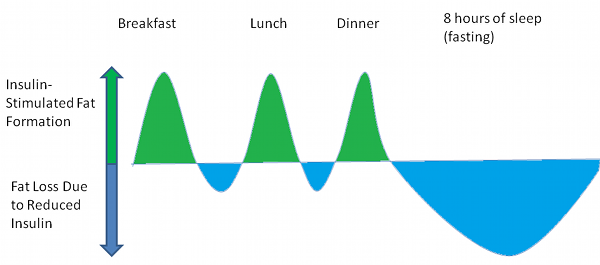
The green portions are the periods where your body has excess energy due to eating food. The blue portions are the periods when the body has no energy left from food and thus has to burn fat for energy.
If the green and blue portions balance out every day–if you store just as much fat as you burn–your weight stays the same. If you store more fat than you burn (by overeating), you get fatter. And if you burn more fat than you store, you get leaner.
Fat stores are simply energy stores and, as the body can’t create excess energy from nothing, they can’t increase unless the body has additional energy to store beyond what it burns (also known as a calorie surplus). By the same token, they can’t be reduced unless energy intake is less than expenditure.
That’s why research has shown that so long as people eat less energy than they burn, they lose fat equally well on high-carbohydrate or low-carbohydrate diets.
That’s also why professor Mark Haub was able to lose 27 pounds on a “convenience store diet” consisting mainly of Twinkies, Little Debbie cakes, Doritos, and Oreos: he simply fed his body less energy than it was burning.
Now, if you’re shaking your head, thinking I’m drinking decade-old Kool-Aid , answer me this:
Why has every single controlled weight loss study conducted in the last 100 years…including countless meta-analyses and systematic reviews…concluded that meaningful weight loss requires energy expenditure to exceed energy intake?
Why have bodybuilders dating back just as far…from Sandow to Reeves and all the way up the line…been using, and continue to use, this knowledge to systematically and routinely reduce and increase body fat levels?
And why do new brands of “calorie denying” come and go every year, failing to gain acceptance in the weight loss literature?
A century of metabolic research has proven, beyond the shadow of a doubt, that energy balance, operating according to the first law of thermodynamics, is the basic mechanism that regulates fat storage and reduction.
The Simple Science of Stubborn Fat
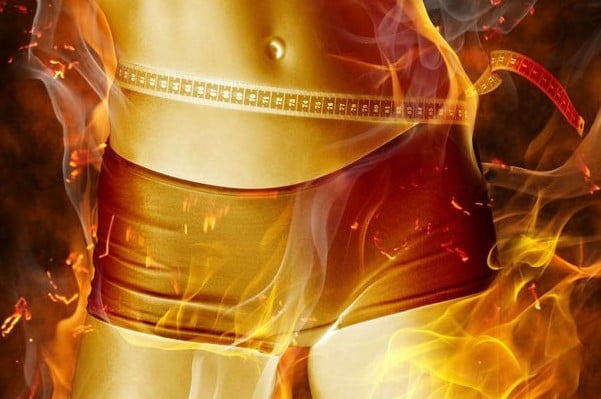
When you eat food, your body breaks it down into various substances and releases insulin in the blood to shuttle the nutrients into your cells.
When you’re in this “fed” state, no fat burning occurs, and depending on how much you eat, this can last for several hours.
This mechanism makes simple physiological sense. Why should your body burn fat for energy when it has all it needs from the food just eaten? It has no reason to and holds onto its valuable fat for when food energy runs out.
To that point, as the nutrients eaten are absorbed, insulin levels decline, and the body senses that its post-meal energy is running out. The body then shifts toward burning fat stores to meet its energy needs.
Day after day, it juggles these states of storing nutrients you eat, and burning its stores when the temporary supplies run out. You can see this depicted in the graph in the previous section.
To burn, or “mobilize,” fat, your body produces chemicals known as catecholamines. These molecules travel through your blood and “attach” to receptors on fat cells, which then triggers the release of the energy stored within the cells to be burned for energy.
Now, fat cells have two types of receptors for catecholamines: alpha- and beta-receptors. To keep this simple, beta-receptors speed up fat mobilization, whereas alpha-receptors hinder it.
And here’s the big difference between “regular” and “stubborn” fat:
Fat that is easy to lose has more beta-receptors than alpha-, and fat that is hard to lose has more alpha-receptors than beta.
This ratio of alpha- and beta-receptors in individual fat cells determines how easy or hard it is to mobilize the energy stored inside.
Thus, when you’re losing fat, you immediately start seeing reductions in fat masses with high amounts of beta-receptors, but the masses with high amounts of alpha-receptors are slow to respond.
For most of us guys, this means steady fat loss in places like our arms, shoulders, chest, face, and legs, and slower fat loss in our stomach area and lower back. For most girls, the stubborn fat is grouped in the hips, thighs, and butt.
So, if that’s the science behind the stubborn pudge, what can we do to get rid of it faster?
4 Strategies to Help You Lose Stubborn Fat Faster
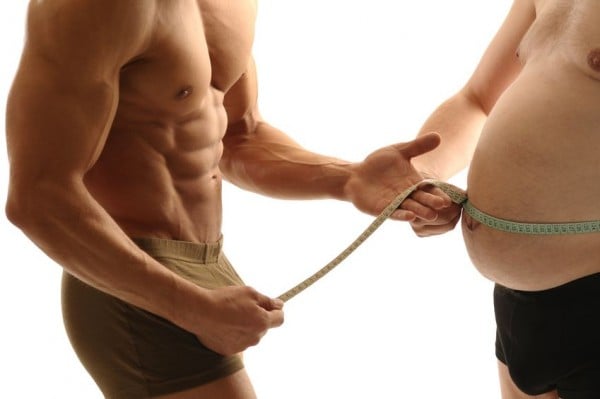
Some people don’t need to do anything special to lose their stubborn fat. They just follow a proper diet and exercise routine and have some patience and voila, they reach their goals smoothly.
They seem to be in the minority, though. I’ve worked with thousands of people and most find that as they get leaner, it gets harder to keep getting leaner. There are various reasons why people can hit weight loss plateaus, but one of the major ones is the fact that as you reduce your body fat percentage, more and more of what remains is stubborn fat. And it can be really stubborn.
That’s why when I cut, I do everything I can that naturally and safely helps the body burn stubborn fat, which is what I’m going to share here.
And in case you’re wondering how well these strategies work, here’s my “summer look,” which I achieve doing exactly what I teach in this article:
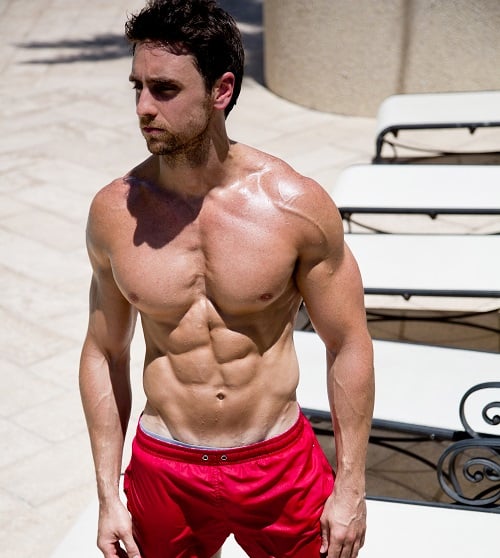
I’ve gotten to the 7% body fat range both with and without the strategies discussed below and I can say definitively that they noticeably speed the process up.
How Fasted Training Helps You Lose Stubborn Fat
Your body is in a “fasted” state when insulin is at a low, baseline level and fat stores are the primary source of energy.
The size and composition of a meal as well as various physical factors determine how long it takes for your body to process and absorb the food you eat and enter a fasted state.
There aren’t hard and fast rules but here’s what you should know:
- ~30 grams of whey protein will take 2 to 3 hours to fully process,
- carbs aren’t the only macronutrient that stimulates insulin production–protein and dietary fat do as well
- dietary fat also slows down the digestion of a mixed meal, causing insulin levels to remain elevated for longer,
The bottom line is the larger the meal, the larger the insulin response and the longer it will take to come back to a fasted state.
This is why most people that train fasted do so first thing in the morning, after at least 8+ hours of time has elapsed since their last meal.
If you can’t do that, then I recommend you eat no more than 30 to 40 grams of protein (whey is particularly good because of how quickly it’s processed) with only trace amounts of carbohydrate and fat (10 grams or less) and wait 3 to 5 hours before exercising.
Now, why bother with fasted training? Because it accelerates fat loss…and especially if combined with a few supplements.
Weight training in a fasted state is particularly effective and training first thing in the morning has an added benefit, as fasting for longer than 6 hours increases your body’s ability to burn fat.
Before we dive into the details, I want to make one thing clear: fasted training doesn’t let you somehow “cheat” the laws of energy balance. If you’re not a calorie deficit, no amount of fasted training is going to help you get leaner.
(And if you feel confused about how many calories, how much of each macronutrient, and which foods you should eat to reach your weight-loss goals, take the Legion Diet Quiz to learn exactly what diet is right for you.)
That said, fasted training does “optimize” fat loss in several ways.
Insulin blunts lipolysis (the breakdown of fat cells for energy) and fat oxidation (the burning of the fatty acids resulting from lipolysis), and that’s why the higher your insulin levels are during exercise, the less fat you’ll burn in those workouts.
This is why research shows that exercising when insulin levels are at a baseline levels burns slightly more fat than exercising with higher insulin levels.
(Remember, though, that the workouts will burn large amounts of glucose, which will cause your body to have to turn to its fat stores for energy sooner than if you hadn’t exercised. This is why exercise done in a fed state (elevated insulin levels) is still effective for losing fat.)
Furthermore, blood flow in the abdominal region is increased when you’re in a fasted state. This means that catecholamines can reach the stubborn fat easier, resulting in more stubborn fat mobilization.
This is why many fitness competitors swear by the strategies outlined in this article for getting rid of the final bits of stubborn fat that take you from “lean” to “shredded.”
Fasted training does have one significant drawback, however: accelerated breakdown of muscle tissue.
This is undesirable because a calorie deficit, which is necessary for losing fat, puts you at a protein turnover disadvantage. Thus, higher amounts of protein degradation can result in more muscle loss.
Fortunately, you can prevent this with proper supplementation.
In the spirit of full disclosure, I want you to know that the supplements I recommend in this article are not just what I personally use but they are from my supplement line, LEGION.
As you probably know, the supplement industry is notorious for its lies and shenanigans. The truth is the majority of the supplements you see in the magazines and on the shelves aren’t going to help you reach your goals faster.
That’s why I decided to create the products I myself have always wanted: science-based formulations, clinically effective dosages of all ingredients, no fillers or unnecessary junk, and natural sweetening and flavoring.
You can learn more about LEGION and my goal to change the supplement industry for the better here.
If you like what you see and decide to support my work…you’re awesome. 🙂 It’s because of people like you that I get to spend my time writing articles like this that help others get into the best shape of their lives.
(And if you feel confused about what supplements you should take to reach your goals, take the Legion Supplement Finder Quiz to learn exactly what supplements are right for you. It’s the best way to ensure you get the most out of your supplement regimen.)
HMB and Muscle Preservation

The supplement β-Hydroxy β-Methylbutyrate (also known as HMB) is a substance formed when your body metabolizes the amino acid leucine, which is an amino acid that directly stimulates protein synthesis.
HMB is often sold as a muscle-building aid but the research purported to demonstrate these benefits is shaky at best, hindered most by design flaws. Thus, I’m not comfortable making any claims about muscle growth.
There is one benefit of HMB that’s well established, however: it’s an extremely effective anti-catabolic agent.
That is, it’s very good at preventing muscle breakdown, which means you will recover faster from your workouts and experience less muscle soreness (and the free acid form shows the most promise in this regard).
It also has no effect whatsoever on insulin levels, which means it can’t break your fasted state.
This makes HMB perfect for use with fasted training. Its powerful anti-catabolic effects and non-existent insulin effects means you reap all the fat loss benefits of training fasted without any of the problems relating to muscle loss or insulin secretion.
It’s also worth noting that HMB is superior to leucine in suppressing muscle breakdown because it’s more anti-catabolic than its “parent” amino acid.
This means it’s also more effective than branched-chain amino acid supplements because they rely on leucine for their anti-catabolic effects (isoleucine and valine are very weak in this regard).
In terms of which specific HMB supplement I recommend, I’ve included a clinically effective dosage in every serving of my pre-workout fat burner FORGE.
FORGE is a fat burner made specifically for use with fasted training and it contains clinically effective dosages of…
- HMB. As you now know, HMB is very good at preventing muscle breakdown, and this means you will recover faster from your workouts and experience less muscle soreness.
- Yohimbine. Research shows that yohimbine enables your body to reduce fat stores faster, and it’s particularly useful as you get leaner and are battling with stubborn fat holdouts.
- Citicoline. CDP-choline (also known as citicoline) is a chemical that occurs naturally in the brain that increases levels of another chemical called phosphatidylcholine, which is vital for brain function.
Research shows that supplementation with CDP-choline improves attentional focus, and I included this in FORGE because most people find fasted training more mentally draining than fed training and CDP-choline can help counteract this.
The bottom line is FORGE helps you lose fat–and “stubborn” fat in particular–faster, preserve muscle, and maintain training intensity and mental sharpness.
Caffeine Helps Burn Fat (and Stubborn Fat)
As weight loss boils down to energy consumed vs. energy expended, caffeine helps you lose fat by increasing your body’s daily energy expenditure.
Caffeine also improves strength, muscle endurance, and anaerobic performance, and also reverses the “morning weakness” experienced by many weightlifters.
Part of maximizing the fat loss benefits of caffeine is preventing your body from building up too much of a tolerance, however. The best way to do this is to limit intake, of course.
Here’s what I recommend:
- Before training, supplement with 3 – 6 mg caffeine per kg of body weight. If you’re not sure of your caffeine sensitivity, start with 3 mg/kg and work up from there.
- Keep your daily intake at or below 6 mg per kg of body weight. Don’t have 6 mg/kg before training and then drink a couple of coffees throughout the day.
- Do 1 – 2 low-caffeine days per week, and 1 no-caffeine day per week. A low day should be half your normal intake, and a no day means less than 50 mg of caffeine (you can have a cup or two of tea, but no coffee, caffeine pills, etc.).
Personally I get my caffeine from my pre-workout PULSE, which contains a dehydrated and concentrated form of caffeine (caffeine anhydrous) shown to be more effective for improving performance than what is naturally found in beverages like coffee.
PULSE also contains clinically effective dosages of 5 other ingredients scientifically proven to improve workout performance:
- Beta-Alanine. Beta-alanine is a naturally occurring amino acid that reduces exercise-induced fatigue, improves anaerobic exercise capacity, and can accelerate muscle growth.
- Citrulline Malate. Citrulline is an amino acid that improves muscle endurance, relieves muscle soreness, and improves aerobic performance.
- Betaine. Betaine is a compound found in plants like beets that improves muscle endurance, increases strength, and increases human growth hormone and insulin-like growth factor 1 production in response to acute exercise.
- Ornithine. Ornithine is an amino acid found in high amounts in dairy and meat that reduces fatigue in prolonged exercise and promotes lipid oxidation (the burning of fat for energy as opposed to carbohydrate or glycogen).
- Theanine. Theanine is an amino acid found primarily in tea that reduces the effects of mental and physical stress, increases the production of nitric oxide, which improves blood flow, and improves alertness, focus, attention, memory, mental task performance, and mood.
And what you won’t find in PULSE is equally special:
- No artificial sweeteners or flavors..
- No artificial food dyes.
- No unnecessary fillers, carbohydrate powders, or junk ingredients.
The bottom line is if you want to know what a pre-workout is supposed to feel like…if you want to experience the type of energy rush and performance boost that only clinically effective dosages of scientifically validated ingredients can deliver…then you want to try PULSE.

Yohimbine is a Powerful Stubborn Fat Loss Aid
Yohimbine is made from the Pausinystalia yohimbe plant, and it helps the body “tap into” fat stores.
(Not a very technical explanation, I know–if you want to know exactly how it works, check out this article of mine on how to lose stubborn fat.)
Yohimbine accelerates weight loss, but only works if you’re training in a fasted state. Elevated insulin levels negate yohimbine’s effects.
I’ve cut both with and without fasted training and yohimbine and I can say with absolutely certainty that with is noticeably faster. So much so that I think the biggest benefits of fasted training are that it lets you use yohimbine and it makes the other supplements discussed in this article more effective.
By itself, fasted training will make a slight difference in how quickly you lose fat. Combined with these supplements, however, it’s quite dramatic.
In terms of dosages, research has shown that 0.2 mg/kg of body weight is sufficient for fat loss purposes, and that ingesting it prior to exercise is particularly effective.
Some people get overly jittery from yohimbine, so I recommend you start with .1 mg/kg of body weight to assess tolerance. If you feel fine, then increase to the clinically effective dosage of 0.2 mg/kg.
Furthermore, yohimbine can raise blood pressure. If you have high blood pressure, I don’t recommend you use it.
In terms of which specific yohimbine supplement I recommend, you’re probably not surprised that I’ve included a clinically effective dosage in every serving of my pre-workout fat burner FORGE.
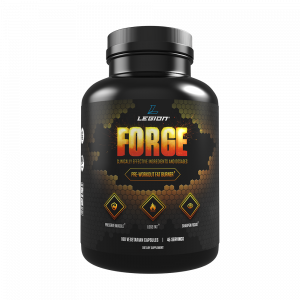
PHOENIX Fat Burner
PHOENIX’s caffeine-free formulation is quite different from FORGE’s and is actually meant to be “stacked” with it (taken together).
PHOENIX helps you burn fat faster in three different ways:
- It dramatically increases metabolic speed.
- It amplifies the power of fat-burning chemicals produced by your body.
- It increases the feeling of fullness from food.
It accomplishes this through clinically effective dosages of several ingredients, including…
- Synephrine. This increases both basal metabolic rate and lipolysis, inhibits the activity of certain fat cell receptors that prevent fat mobilization, and increases the thermic effect of food (the “energy cost” of metabolizing food).
- Naringin. This stimulates the production of a hormone called adiponectin, which is involved in the breakdown of fat cells, and that it activates a type of receptor in fat cells that regulates fat mobilization (the PPARα receptor).
Through these mechanisms, naringin also works synergistically with synephrine and hesperidin to further accelerate the basal metabolic rate.
- Hesperidin. Like naringin, this also stimulates the production of adiponectin and activates the PPARa receptor. It also improves blood flow and reduces the inflammation of blood vessels.
- Epigallocatechin gallate (EGCG). This inhibits the activity of a different enzyme also responsible for breaking down neurotransmitters that induce lipolysis. It has also been shown to reduce abdominal fat in particular.
- Forskolin. This increases blood plasma and intracellular levels of a molecule known as cAMP. When cAMP is high, it signifies a lack of ATP (the most basic form of cellular energy in the body) and thus initiates a process to make more ATP by burning through energy reserves (body fat).
Research has shown that supplementation with forskolin accelerates fat loss and increases testosterone levels.
- And more…
The bottom line is if you want to lose fat faster without pumping yourself full of stimulants or other potentially harmful chemicals…then you want to try PHOENIX.
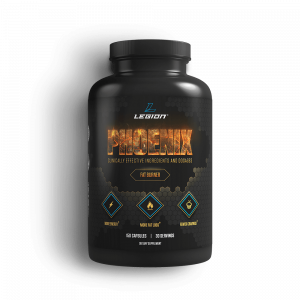
How to Use These Supplements Properly
Here’s what I take before my fasted training sessions:
(NOTE: Taking green tea extract, which is in PHOENIX, on an empty stomach can make some people nauseous. If that happens to you, take it with food and you’ll be fine.)
When I’m dieting for fat loss, I lift weights in a fasted state 5 days per week and do 25 to 30 minutes of HIIT cardio in a fasted state 3 to 4 times per week.
On the days where I’m doing both weightlifting and cardio, I take the above before both training sessions and have no issues.
Oh, and if you aren’t sure if the supplements discussed in this article are right for your budget, circumstances, and goals, then take the Legion Supplement Finder Quiz! In less than a minute, it’ll tell you exactly what supplements are right for you. Click here to check it out.
The Bottom Line on Losing Stubborn Fat

Make no mistake–stubborn fat can be a real pain in the ass.
Depending on your genetics and circumstances, it can cling to your bones for dear life. Or, if you’re lucky, it can melt away with relative ease.
Either way, rest assured that you CAN get rid of it. Follow the strategies in this article and you’ll get there. Let me know when you do. 🙂
What’s your take on losing stubborn fat? Have anything else to share? Let me know in the comments below!
+ Scientific References
- Millan MJ, Newman-Tancredi A, Audinot V, et al. Agonist and antagonist actions of yohimbine as compared to fluparoxan at alpha(2)-adrenergic receptors (AR)s, serotonin (5-HT)(1A), 5-HT(1B), 5-HT(1D) and dopamine D(2) and D(3) receptors. Significance for the modulation of frontocortical monoaminergic transmission and depressive states. Synapse. 2000;35(2):79-95. doi:10.1002/(SICI)1098-2396(200002)35:2<79::AID-SYN1>3.0.CO;2-X
- Staten MA, Bier DM, Matthews DE. Regulation of valine metabolism in man: a stable isotope study. Am J Clin Nutr. 1984;40(6):1224-1234. doi:10.1093/ajcn/40.6.1224
- Doi M, Yamaoka I, Nakayama M, Sugahara K, Yoshizawa F. Hypoglycemic effect of isoleucine involves increased muscle glucose uptake and whole body glucose oxidation and decreased hepatic gluconeogenesis. Am J Physiol Endocrinol Metab. 2007;292(6):E1683-93. doi:10.1152/ajpendo.00609.2006
- Wilson JM, Lowery RP, Joy JM, et al. β-Hydroxy-β-methylbutyrate free acid reduces markers of exercise-induced muscle damage and improves recovery in resistance-trained men. Br J Nutr. 2013;110(3):538-544. doi:10.1017/S0007114512005387
- Rowlands DS, Thomson JS. Effects of beta-hydroxy-beta-methylbutyrate supplementation during resistance training on strength, body composition, and muscle damage in trained and untrained young men: a meta-analysis. J strength Cond Res. 2009;23(3):836-846. doi:10.1519/JSC.0b013e3181a00c80
- Kimball SR, Jefferson LS. Signaling pathways and molecular mechanisms through which branched-chain amino acids mediate translational control of protein synthesis. J Nutr. 2006;136(1 Suppl):227S-31S. doi:10.1093/jn/136.1.227S
- Pitkänen HT, Nykänen T, Knuutinen J, et al. Free amino acid pool and muscle protein balance after resistance exercise. Med Sci Sports Exerc. 2003;35(5):784-792. doi:10.1249/01.MSS.0000064934.51751.F9
- Gjedsted J, Gormsen LC, Nielsen S, et al. Effects of a 3-day fast on regional lipid and glucose metabolism in human skeletal muscle and adipose tissue. Acta Physiol (Oxf). 2007;191(3):205-216. doi:10.1111/j.1748-1716.2007.01740.x
- Febbraio MA, Chiu A, Angus DJ, Arkinstall MJ, Hawley JA. Effects of carbohydrate ingestion before and during exercise on glucose kinetics and performance. J Appl Physiol. 2000;89(6):2220-2226. doi:10.1152/jappl.2000.89.6.2220
- Achten J, Jeukendrup AE. The effect of pre-exercise carbohydrate feedings on the intensity that elicits maximal fat oxidation. J Sports Sci. 2003;21(12):1017-1024. doi:10.1080/02640410310001641403
- Cimmino M, Agosto A, Minaire Y, Géloën A. In situ regulation of lipolysis by insulin and norepinephrine: a microdialysis study during euglycemic-hyperinsulinemic clamp. Metabolism. 1995;44(12):1513-1518. doi:10.1016/0026-0495(95)90067-5
- Achten J, Jeukendrup AE. Optimizing fat oxidation through exercise and diet. Nutrition. 20(7-8):716-727. doi:10.1016/j.nut.2004.04.005
- Kraemer WJ, Fleck SJ, Maresh CM, et al. Acute hormonal responses to a single bout of heavy resistance exercise in trained power lifters and untrained men. Can J Appl Physiol. 1999;24(6):524-537. http://www.ncbi.nlm.nih.gov/pubmed/10638340. Accessed September 16, 2019.
- Derave W, Mertens A, Muls E, Pardaens K, Hespel P. Effects of post-absorptive and postprandial exercise on glucoregulation in metabolic syndrome. Obesity (Silver Spring). 2007;15(3):704-711. doi:10.1038/oby.2007.548
- Ercan N, Gannon MC, Nuttall FQ. Effect of added fat on the plasma glucose and insulin response to ingested potato given in various combinations as two meals in normal individuals. Diabetes Care. 1994;17(12):1453-1459. doi:10.2337/diacare.17.12.1453
- Manco M, Calvani M, Mingrone G. Effects of dietary fatty acids on insulin sensitivity and secretion. Diabetes Obes Metab. 2004;6(6):402-413. doi:10.1111/j.1462-8902.2004.00356.x
- Manders RJF, Hansen D, Zorenc AHG, et al. Protein co-ingestion strongly increases postprandial insulin secretion in type 2 diabetes patients. J Med Food. 2014;17(7):758-763. doi:10.1089/jmf.2012.0294
- Strosberg AD. Structure, function, and regulation of adrenergic receptors. Protein Sci. 1993;2(8):1198-1209. doi:10.1002/pro.5560020802
- Lefkowitz RJ. Direct binding studies of adrenergic receptors: Biochemical, physiologic, and clinical implications. Ann Intern Med. 1979;91(3):450-458. doi:10.7326/0003-4819-91-3-450
- Surina DM, Langhans W, Pauli R, Wenk C. Meal composition affects postprandial fatty acid oxidation. Am J Physiol. 1993;264(6 Pt 2):R1065-70. doi:10.1152/ajpregu.1993.264.6.R1065
- Newsholme EA, Dimitriadis G. Integration of biochemical and physiologic effects of insulin on glucose metabolism. Exp Clin Endocrinol Diabetes. 2001;109 Suppl 2:S122-34. doi:10.1055/s-2001-18575
- Hand GA, Shook RP, Paluch AE, et al. The energy balance study: the design and baseline results for a longitudinal study of energy balance. Res Q Exerc Sport. 2013;84(3):275-286. doi:10.1080/02701367.2013.816224
- Sacks FM, Bray GA, Carey VJ, et al. Comparison of weight-loss diets with different compositions of fat, protein, and carbohydrates. N Engl J Med. 2009;360(9):859-873. doi:10.1056/NEJMoa0804748
- Andersen V, Fimland MS, Brennset O, et al. Muscle activation and strength in squat and Bulgarian squat on stable and unstable surface. Int J Sports Med. 2014;35(14):1196-1202. doi:10.1055/s-0034-1382016
- Speirs DE, Bennett MA, Finn C V., Turner AP. Unilateral VS. Bilateral squat training for strength, sprints, and agility in academy rugby players. J Strength Cond Res. 2016;30(2):386-392. doi:10.1519/JSC.0000000000001096











